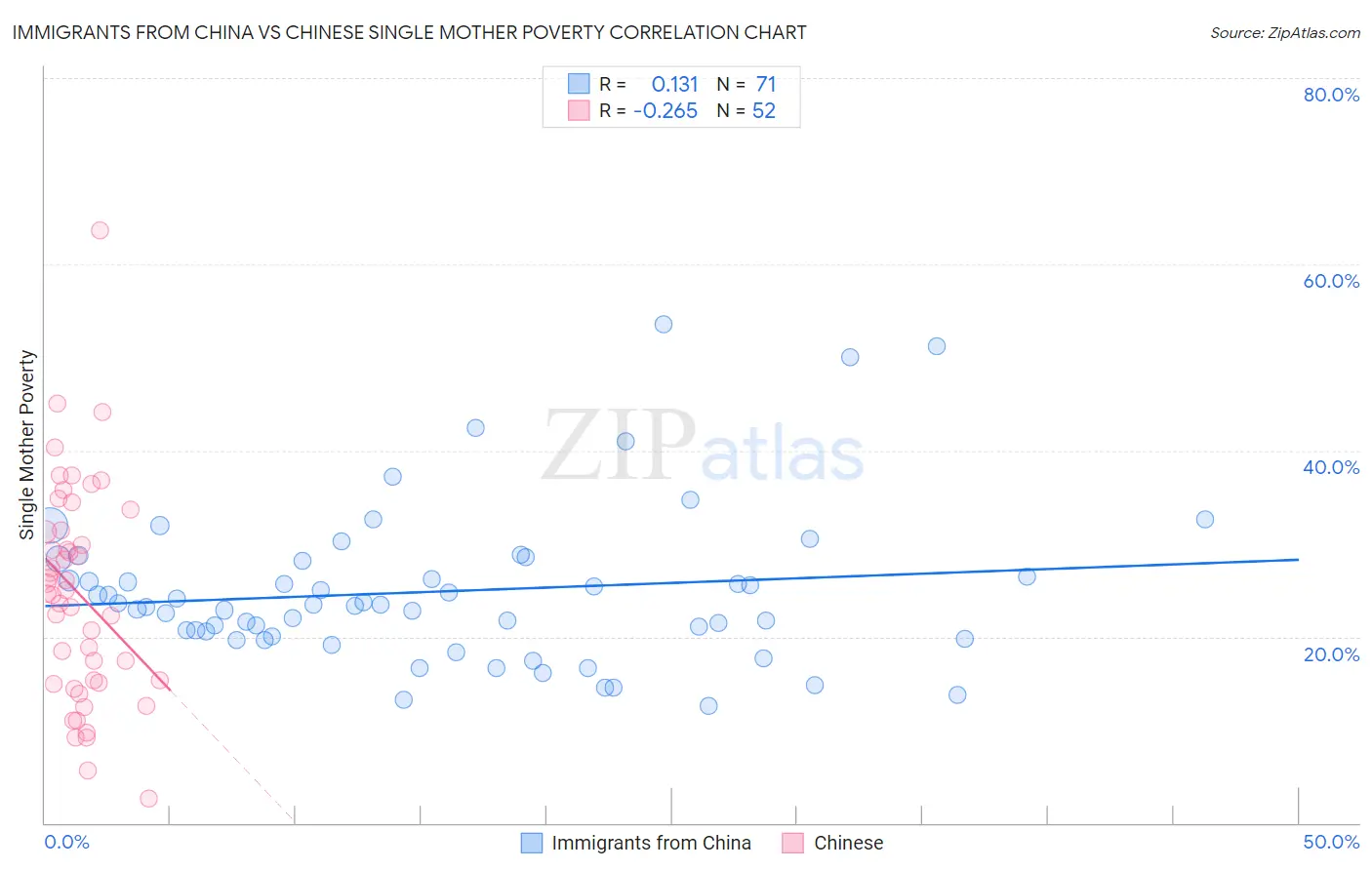Immigrants from China vs Chinese Single Mother Poverty
COMPARE
Immigrants from China
Chinese
Single Mother Poverty
Single Mother Poverty Comparison
Immigrants from China
Chinese
26.1%
SINGLE MOTHER POVERTY
100.0/ 100
METRIC RATING
20th/ 347
METRIC RANK
24.6%
SINGLE MOTHER POVERTY
100.0/ 100
METRIC RATING
7th/ 347
METRIC RANK
Immigrants from China vs Chinese Single Mother Poverty Correlation Chart
The statistical analysis conducted on geographies consisting of 441,985,494 people shows a poor positive correlation between the proportion of Immigrants from China and poverty level among single mothers in the United States with a correlation coefficient (R) of 0.131 and weighted average of 26.1%. Similarly, the statistical analysis conducted on geographies consisting of 64,411,570 people shows a weak negative correlation between the proportion of Chinese and poverty level among single mothers in the United States with a correlation coefficient (R) of -0.265 and weighted average of 24.6%, a difference of 6.0%.

Single Mother Poverty Correlation Summary
| Measurement | Immigrants from China | Chinese |
| Minimum | 12.6% | 2.6% |
| Maximum | 53.5% | 63.6% |
| Range | 41.0% | 61.1% |
| Mean | 24.9% | 24.6% |
| Median | 23.4% | 24.8% |
| Interquartile 25% (IQ1) | 20.0% | 15.2% |
| Interquartile 75% (IQ3) | 28.2% | 31.4% |
| Interquartile Range (IQR) | 8.2% | 16.2% |
| Standard Deviation (Sample) | 8.3% | 11.6% |
| Standard Deviation (Population) | 8.2% | 11.4% |
Demographics Similar to Immigrants from China and Chinese by Single Mother Poverty
In terms of single mother poverty, the demographic groups most similar to Immigrants from China are Immigrants from Eastern Asia (26.1%, a difference of 0.13%), Immigrants from Bolivia (26.2%, a difference of 0.19%), Immigrants from Pakistan (26.0%, a difference of 0.27%), Immigrants from Korea (26.2%, a difference of 0.36%), and Burmese (26.2%, a difference of 0.54%). Similarly, the demographic groups most similar to Chinese are Thai (24.5%, a difference of 0.54%), Immigrants from Hong Kong (24.4%, a difference of 1.0%), Filipino (24.3%, a difference of 1.3%), Immigrants from Iran (25.1%, a difference of 2.0%), and Immigrants from Lithuania (25.2%, a difference of 2.4%).
| Demographics | Rating | Rank | Single Mother Poverty |
| Immigrants | Taiwan | 100.0 /100 | #3 | Exceptional 23.9% |
| Filipinos | 100.0 /100 | #4 | Exceptional 24.3% |
| Immigrants | Hong Kong | 100.0 /100 | #5 | Exceptional 24.4% |
| Thais | 100.0 /100 | #6 | Exceptional 24.5% |
| Chinese | 100.0 /100 | #7 | Exceptional 24.6% |
| Immigrants | Iran | 100.0 /100 | #8 | Exceptional 25.1% |
| Immigrants | Lithuania | 100.0 /100 | #9 | Exceptional 25.2% |
| Immigrants | South Central Asia | 100.0 /100 | #10 | Exceptional 25.3% |
| Iranians | 100.0 /100 | #11 | Exceptional 25.5% |
| Bhutanese | 100.0 /100 | #12 | Exceptional 25.6% |
| Indians (Asian) | 100.0 /100 | #13 | Exceptional 25.8% |
| Immigrants | Singapore | 100.0 /100 | #14 | Exceptional 25.8% |
| Immigrants | Ireland | 100.0 /100 | #15 | Exceptional 25.8% |
| Bolivians | 100.0 /100 | #16 | Exceptional 25.9% |
| Asians | 100.0 /100 | #17 | Exceptional 26.0% |
| Immigrants | Pakistan | 100.0 /100 | #18 | Exceptional 26.0% |
| Immigrants | Eastern Asia | 100.0 /100 | #19 | Exceptional 26.1% |
| Immigrants | China | 100.0 /100 | #20 | Exceptional 26.1% |
| Immigrants | Bolivia | 100.0 /100 | #21 | Exceptional 26.2% |
| Immigrants | Korea | 100.0 /100 | #22 | Exceptional 26.2% |
| Burmese | 100.0 /100 | #23 | Exceptional 26.2% |